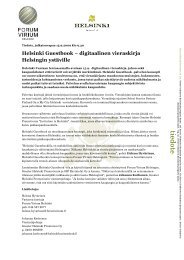FinPilot2 Final Report â User Acceptance of Mobile TV Services ...
FinPilot2 Final Report â User Acceptance of Mobile TV Services ...
FinPilot2 Final Report â User Acceptance of Mobile TV Services ...
You also want an ePaper? Increase the reach of your titles
YUMPU automatically turns print PDFs into web optimized ePapers that Google loves.
2.3 Other studies<br />
The usage <strong>of</strong> mobile phones evolves in three general user spheres <strong>of</strong> home, work and<br />
public. Quite typically, mobile phones are regarded as devices for use in the public<br />
sphere, for example while waiting or commuting. They are used to kill time and to<br />
keep their users entertained or up-to-date (Oksman et al., 2007). Some studies have<br />
shown that mobile services are measurably used in the private area. For example<br />
a mobile television pilot in Oxford, UK, revealed that about 50 percent <strong>of</strong> the test<br />
users viewed mobile television at home and didn’t move anywhere while viewing. A<br />
typical time for using mobile television was late night, in bed, just before one was<br />
falling asleep. (Dowell, 2006).<br />
Cui, Chipchase and Jung (2007) carried out a qualitative study <strong>of</strong> eight young<br />
early adopters <strong>of</strong> mobile <strong>TV</strong> in Seoul, South Korea four months after the launching<br />
<strong>of</strong> mobile <strong>TV</strong> service. With these users, the average weekly use was over 6 hours.<br />
The novelty value was the main motivation <strong>of</strong> adopting mobile <strong>TV</strong>, and the users<br />
felt that this was one more gadget to try. Typical usage situations were killing time<br />
while commuting, personal use at home, secret use at school and macro breaks. Cui<br />
et al. emphasize that breaks needed to be long enough to have time to set up the<br />
device, e.g. changing channel took up to ten seconds. That is why they introduce<br />
the concept <strong>of</strong> macro breaks. The most popular content in this trial were radio<br />
channels. Cui et al. suggest that mobile <strong>TV</strong> should rather be called personal <strong>TV</strong>,<br />
even if in their trial shared watching with up to three friends was usual. However,<br />
the value <strong>of</strong> mobile <strong>TV</strong> seemed to be in personal use rather than mobility.<br />
The use <strong>of</strong> mobiles in the public sphere has certain limitations. For example users<br />
have been worried about becoming absorbed in mobile multimedia content, which<br />
requires their visual attention. They fear increased risks <strong>of</strong> accidents and lapses.<br />
The possibility <strong>of</strong> listening to music or the radio while on the move is thus highly<br />
valued, because it doesn’t need visual attention. Also text legibility may be difficult<br />
when on the move (Knoche, 2005). Digital music is one <strong>of</strong> the most popular forms<br />
<strong>of</strong> mobile entertainment and it is supposed to be a key driver for customer adoption<br />
<strong>of</strong> new 3G services. According to a Siemens survey, the most attractive applications<br />
for American consumers are mobile email, mobile music and mobile <strong>TV</strong> (Siemens<br />
Communications, 2006).<br />
The findings <strong>of</strong> a number <strong>of</strong> studies made on mobile <strong>TV</strong> show that the most popular<br />
content is news. (Södergård, 2003; Knoche & McCarthy, 2004; Mäki, 2005). News<br />
is well suited to mobile phones, because the use <strong>of</strong> mobile <strong>TV</strong> bursts <strong>of</strong>ten lasts<br />
less than 10 minutes. Knoche and McCarthy (2004) list mobile television content<br />
types by their popularity as 1. news, 2. music, 3. sports, 4. cartoons, 5. movies, 6.<br />
soap operas, and 7. sitcoms. Although short watching sessions are typical to mobile<br />
<strong>TV</strong>, longer durations (20-40 min) were also observed in the trials by Oksman et al.<br />
(2008).<br />
20












